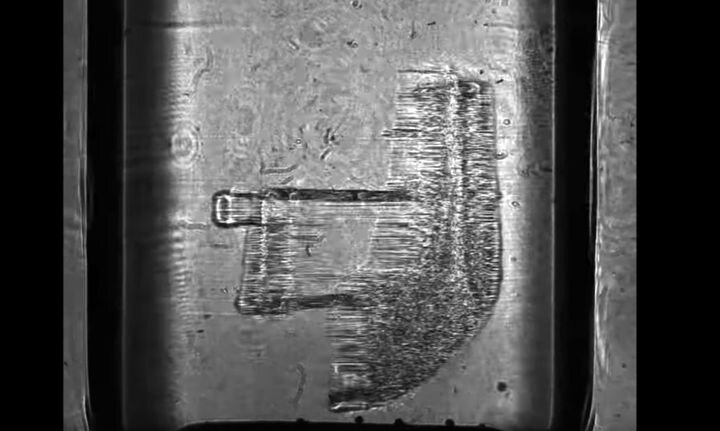![A #3DBenchy being 3D printed using a volumetric 3D printing process [Source: Readily3D]](https://fabbaloo.com/wp-content/uploads/2020/05/image-asset_img_5eb0509c12811.jpg)
There’s been some chatter about volumetric 3D printing recently, and I thought I’d speculate on the implications of the new 3D printing approach.
Conventional 3D Printing
3D printing is not a new technology; indeed, it was invented in the 1980s by three independent inventors who developed the initial processes, and who eventually leveraged them into today’s 3D printing giants.
While quite a bit different from each other, all of the initial 3D printing processes had a similarity: layer-based deposition. FDM, SLA and SLS all use the paradigm of layering. Software divides the 3D model into layers whose shapes are transformed into GCODE to be executed on the respective 3D printers. They each would build prints layer by layer, in their own way.
The problem is that these layer-by-layer approaches are tedious.
In other traditional making methods things progress much faster. Take injection molding, for example: the material is squirted into the mold and seconds later it solidifies and the entire process is complete. Stamping is similarly identical. Only CNC milling, a subtractive approach, ranks among the speeds of 3D printers.
3D printing using today’s technologies is therefore quite slow. Small 3D prints may a few hours, while larger 3D prints can take literally days or weeks to complete. Delays of this magnitude are completely unacceptable for many applications.
Volumetric 3D Printing
Volumetric 3D printing is a new approach that does away with the layer concept entirely. Instead of building layers one at a time, the concept involves projecting rotating images into a vat of photopolymer or similar material that is essentially the reverse of a CT Scan. Instead of capturing a 3D model from multiple images, the volumetric approach creates a 3D print by projecting multiple images.
The process must use transparent liquid photopolymer resin as the light images must sink deep into the liquid to allow for simultaneous solidification in all areas of the 3D model.
The result is that 3D printing can take place very quickly. There’s a useful analogy here: DLP 3D printers are usually faster than SLA 3D printers because instead of having a laser traverse each and every solid spot on a layer, the entire layer is illuminated simultaneously. That’s faster. But in the volumetric approach, the entire 3D model is illuminated at all depths simultaneously in a vat of reactive resin. It’s a quantum step forward, speed wise.
We’re aware of three organizations working on this technology, including Readily3D, which we reported on yesterday, researchers at Berkeley, and Prof. Adrian Bowyer’s Electric 3D Printing concept.
There are likely others working on similar processes, but in stealth mode. It’s quite likely more than one will suddenly appear later this year or next.
Volumetric 3D Printing Speculation
If one or more of these ventures is successful, then we could see some interesting effects in the world of 3D printing, but I think it all depends on the materials.
There are plenty of resin 3D printers available on the market today, and some of them are quite fast. There are at least six different approaches for allowing “continuous 3D printing”, where layers are blurred and the printing happens without discrete layer changes. But none of these would approach the speed of the volumetric process.
If all other aspects are equal, then clients would obviously prefer to receive 3D prints more rapidly. This would dramatically increase the throughput on machines, and service bureaus would be ecstatic over the change. Instead of investing, say, US$100K in a machine that prints 100 items per day for clients, what if that same investment yielded a machine that could print 100,000 items per day? It would be spectacularly more profitable.
There’s one worrying aspect of volumetric 3D printing, and that is that it seems the resin must be transparent, at least to the frequency of the light being projected towards it. Having used a number of different resins, I have yet to see any that are in fact transparent. Most are quite opaque as they are a mix of a photopolymer and other substances that provide the desired engineering properties.
So it remains to be seen what kind of materials are truly possible in volumetric systems. If a volumetric venture wishes to succeed, I suspect they had better organize a sophisticated chemical and materials department to ensure there are a variety of different materials available and those that offer desirable properties.
It would be a significant blow to volumetric aspirations if only fragile prototype-level materials were possible. But we don’t know much about that yet, and I’m sure we’ll hear more in the near future.
If these approaches worked and provided proper material options, then we could be in a state of revolution for the industry. Who would choose a 3D printer that would take 1000X longer to print an item? Those companies without a volumetric option would be scrambling to justify the use of their older and slower products. Perhaps they could cite the availability of materials, build volumes or some other twist, but they could suddenly find themselves relegated to the sidelines.

